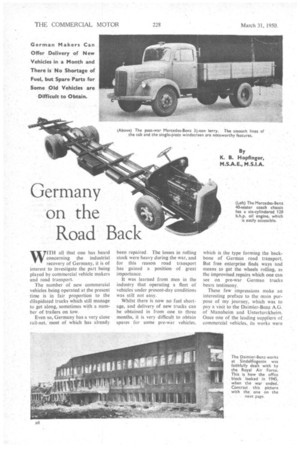Germany • on the Road Back
Page 42

Page 43

If you've noticed an error in this article please click here to report it so we can fix it.
WITH all that one has heard concerning the industrial
. recovery of Germany, it is of interest to investigate the part being played by commercial vehicle makers and road transport.
The number of new commercial vehicles being operated at the present time is in fair proportion to the dilapidated trucks which still manage to get along, sometimes with a number of trailers on tow.
Even so, Germany has a very close rail-net, most of which has already been repaired. The losses in rolling stock were heavy during the war, and for this reason road transport has gained a position of great importance.
It was learned from men in the industry that operating a fleet of vehicles under present-day conditions was still not easy.
Whilst there is now no fuel shortage, and delivery of new trucks can be obtained in from one to three months, it is very difficult to obtain spares for some pre-war vehicles, which is the type forming the backbone of German road transport. But free enterprise finds ways and means to get the wheels rolling, as the improvised repairs which one can see on pre-war German trucks bears testimony.
These few impressions make an interesting preface to the main purpose of my journey, which was to pay a visit to the Daimler-Benz A.G. of Mannheim and Unterturckheim. Once one of the leading suppliers of commercial vehicles, its works were reduced to heaps of ruins thtough Allied air attacks. How production was ever again started is no mystery if one realizes that the German manufacturer was not faced with restrictive measures and that a surplus of manpower was available.
Although the initial reconstruction was no easy task, it was accomplished at a fantastic speed, and with the help of Marshall Aid it was possible to obtain some of the most essential machinery.
The commercial vehicle programme of the Mercedes-Benz concern is centred round two types of engine which are used in four different chassis. A 3i-ton truck chassis, known as the L3500, is powered by a 90 b.h.p. six-cylindered oil engine, working on the Mercedes-Benz precombustion-chamber principle. The chassis is, in every respect, similar to the pre-war design and is priced at £1,070. Complete with an all-steel cab and platform body measuring 12 ft, 5 ins. by 7 ft. 5 ins. with 1-ft. 7-in.-high side boards, the vehicle is priced at £1,112. A 5-tonner, known as the L5000, and fitted with a six-cylindered 120 b.h.p. engine, is available in chassis form at £1,770. As a complete vehicle, with platform body having dimensions of 16 ft. 5 ins. by 7 ft. 5 ins., it sells at £1,980.
A coach chassis, employing a 90 b.h.p. oil engine, with a 29-seater light-metal sliding-roof coach body, is available at £2,820. With a 120 b.h.p. engine and 40-seater body the price is £4,070.
Whilst the general features of the vehicles have not varied to any great extent from pre-war design a considerable number of •detail improvements has been introduced. Particular attention has been paid to fuel economy, through developments connected with the combustion chamber of the engine, and attention has been paid to the design of the gearbox. This unit now provides for five forward speeds, four gears having helical teeth to give silent operation.
Further improvements have taken place in the design of the steering, and the hydraulically operated brakes
have been increased in frictional area. The hand brake, which takes effect on only the rear wheels; has a pistol-grip lever mounted beneath the steering wheel. Considerable changes are noticeable in the design of the cab, which is now fitted with a heater system and a demister for the windscreen. The windows in the cab doors are in two parts, one which can be lowered, and a smaller swivelling window, which can provide good
ventilation without draught. .
The suspension is now much softer, and double-acting hydraulic shock absorbers are used on the front axle. ,
-Whilst the changes in design represent nothing radically new, the revised features have been based on sound engineering principles.
Looking back on this. visit to the Daimler-Benz works, it is of interest to recall that in 1945 the total production of commercial vehicles in Germany was only 5,869, and that by 1948 it had reached 34,480. 'Last year the figure was 59,519--a remarkable recovery for an industry which, five years ago, lay in ruins.




























































































